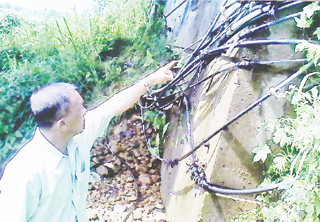Oath stone puts spotlight on the interior
Published on: Friday, January 02, 2015

KENINGAU: The Oath Stone, floods, wildlife hunting, landslips. These were some of the highlights from the Interior in 2014 and caused concern to the people residing in the areas.As early as January, about 5,000 people in Keningau alleged that rampant water thefts, which had been going on for a decade, had affected their water supply as well as threatened the safety of the bridge in Pegalan River.The water thefts were so obvious especially when a short survey by the villagers there showed as many as 20 water pipes connected to the water main.
ADVERTISEMENT
A 15-hour downpour in February flooded Keningau and Tenom, cutting road access after water rose as high as 1.3 metres. The flood was the worst incident since Greg Storm in 1996, affecting not less than 100 villages along Sg Pegalan, Sg Padas and Sg Tomani.Landslips along Penampang-Tambunan road also caused the route inaccessible and travellers were forced to use alternative roads in order to go to the interior.Public Works Department (PWD) Director Datuk John Anthony had said that the cost to repair the damaged road will run up to RM25 million and will take about eight months. Currently, only small and lightweight vehicles are allowed to use the road.
ADVERTISEMENT
Although 18 years have passed, the Greg Storm had left a harrowing mark in its wake. The bridge near Keningau Tamu Ground which was destroyed by the powerful storm is still in a dilapidated state.According to PKR Council of Elder Deputy Chairman Robert Linggi, the bridge could have been used by more than 10,000 people who instead have to use the main road which is very dangerous.
ADVERTISEMENT
He also called on the Prime Minister Datuk Seri Najib Razak to distribute Federal budget to three parts namely Sabah, Sarawak and Peninsular Malaysia simply because in comparison, even Sook is bigger than Perlis and Melaka combined.The sand mining activities in Sg Pegalan also drew the attention of Bingkor Assemblyman Datuk Jeffrey Kitingan who urged the government to stop issuing licences to the quarry operators here for the sake of the people living along the river.Jeffrey said the activity is one of the reasons for the high number of death by drowning in the river.Earlier, a 16-year-old student drowned while crossing the flooded Sg Pegalan on a bridge and his body was not found until four days later. The deceased's brother who was with him, however, managed to save himself while the victim was carried away by the current. Because of this incident, Liawan Assemblyman Datuk Sairin Karno announced that the government will provide a boat and an engine for each village along the river as part of the government's initiatives in providing security to the people here.Meanwhile, Keningau Wildlife Department officer Benedict Jani warned the public that killing wildlife without permit is an offence and offenders can be fined up to RM30,000 or three years imprisonment or both. The law also includes wildlife found on private lands. He added that those caught keeping animals or birds without licence can also be fined under the law.Among the wildlife defined under this law were elephants, bears, orang-utans, crocodiles, turtles, green tortoises, and others.The Oath Stone had also drawn much attention this year with the majority of local leaders from the interior supporting calls to restore the phrase 'Kerajaan Malaysia Jamin' to the Oath Stone plaque, currently kept at the compound of Keningau District Office.Members of NGOs had also issued calls to the relevant authorities to find out who was responsible in taking out the phrase and whether it was on purpose and the reason behind it.They claimed that the Oath Stone has lost its significance with the removal of the phrase. The Oath Stone is the only such form of acceptance known in the world where an indigenous community's response towards the formation of a new nation was finally secured after their wishes to have their demands cast in stone were met. It was erected in 1964 with permission granted by the outgoing British administration when it was found out that the Interior natives led by OKK Sedomon were still opposed to the colony of British North Borneo becoming Sabah through the formation of Malaysia (by way of merger with Malaya, Singapore and Sarawak) a year earlier on 16.9.1963. The appointed State Government of then Chief Minister Donald (later Tun Fuad Stephens) despatched then Keningau Resident Richard Lind (now Tan Sri) to find out what could be done to appease them. In return for their acceptance of Malaysia, the natives told Lind that they did not trust whatever was promised on paper in the discussions leading to the merger unless they were cast in stone. These related to three of the key 20-Points, namely freedom of religion, jurisdiction over State land and preservation of native customs. Stay up-to-date by following Daily Express’s Telegram channel.
Daily Express Malaysia




